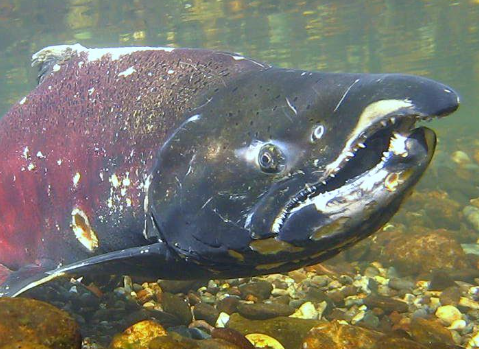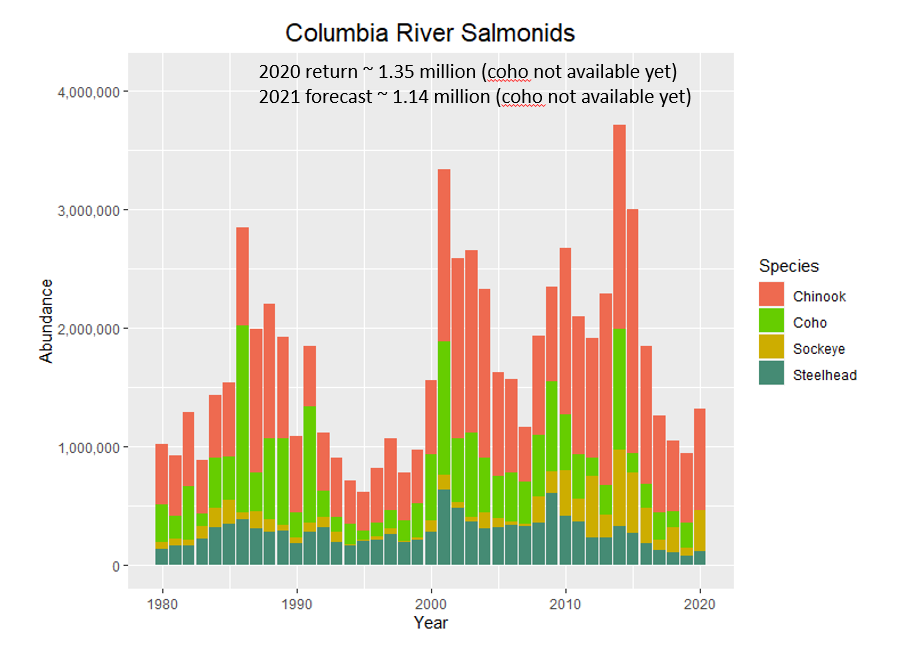With Few Exceptions, Columbia River Salmon and Steelhead Returns Continue Downward Trend
- March 12, 2021
- John Harrison

Salmon and steelhead returns to the Columbia River in 2021, estimated as the number of potential spawners entering the mouth of the river, are predicted to be lower this year (about 1.14 million) than in 2020 (about 1.35 million), but that total could rise substantially if the current prediction for a remarkable return of coho – nearly 1.6 million fish – proves accurate.
State fish and wildlife managers for Idaho, Oregon, and Washington reported their 2021 forecasts at the March meeting of the Council.
The forecasts are developed by the U.S. v. Oregon Technical Advisory Committee (TAC), which includes staff from federal, tribal and state agencies. The TAC ‘reconstructs’ Columbia River salmon and steelhead returns from the previous year and develops forecasts of returns for the current year. U.S. v. Oregon was a federal court proceeding, first brought in 1968, that enforces the reserved fishing rights of four Columbia River tribes in the mid-Columbia area that signed treaties with the U.S. government in 1855 and historically fished in the Columbia. The TAC meets regularly to adjust fisheries to meet management guidelines including mandated ESA harvest limits and allocation of fisheries among tribes and states.

Tim Sippel, a fishery analyst with the Washington Department of Fish and Wildlife and current TAC chair, told the Council that the 2021 run size estimates are mostly lower than the actual 2020 run sizes and continue an overall declining trend with some exceptions. For example, the prediction for fall-run upriver bright fall Chinook, which spawn in the Hanford Reach of the Columbia between about Richland, Washington, and Priest Rapids Dam, is 354,200. That’s more than the 2020 return of 299,300, but still below the recent 10-year average for the species.
“Hopefully we are improving, but we shall see,” Sippel said.
The total return of fall Chinook is predicted at 580,800, which is close to the 2020 return of 577,400. The forecast for sockeye is 155,600, far lower than the 2020 return of 342,300. “It has been challenging to predict sockeye returns,” Sippel said. “There seems to be some changes in the biological responses to different conditions that we haven’t picked apart yet.”
The spring Chinook run in the lower Columbia – below Bonneville Dam – is forecasted at 68,000 fish, an improvement over last year’s 61,229, but the return of upriver spring Chinook (above Bonneville Dam) is expected to be lower than in 2020. The TAC predicts the upper Columbia summer Chinook run will be 77,600 fish, an improvement from last year’s 65,494 fish.
The coho forecast is drawing the most interest: 1,590,000 fish, compared to 363,200 in 2020. But there is a caveat: the current prediction is for the number of adult coho in the ocean this year. “We don’t have a forecast for the Columbia River yet; that is being worked out now,” Sippel said. “But this has raised some eyebrows, for sure.”
Sippel noted there is interest in exploring new approaches to forecasting. Steelhead returns, for example, are notoriously difficult to forecast, partly because there are two distinct runs that spawn at different times and in different places. “There is a lot of uncertainty in the biology of these animals, and that makes it particularly difficult to forecast,” he said. For 2021, the A run steelhead forecast is higher than the 2020 return (89,200 vs. 75,392 in 2020), but the B run forecast is significantly lower (7,600 vs. 32,199 in 2020). Those runs are a mix of hatchery and natural-origin fish, and the natural component of both runs is low.
The predictions for salmon and steelhead returning to the Snake River Basin are mixed, but generally not encouraging. While it appears the return of wild spring/summer Chinook will be high enough to allow fishing “without presenting ESA problems,” as Idaho Department of Fish and Game biologist Chris Sullivan put it, the predicted 8,150-fish return is below the recent 10-year average of 14,259, and last year’s 8,565 fish. The forecast for hatchery-origin spring/summer Chinook, 18,783, is below last year’s return (21,564), and the 10-year average of 48,227.
There is a bit of good news in Idaho, though, and it regards fall Chinook, listed as a threatened species. The 2021 forecast is for 17,500 hatchery-origin fish, and even though that is below the recent 10-year average (25,499), Sullivan said, “generally speaking, this population is a bit of a success story.” He said credit goes to the Nez Perce Tribe, which has developed a successful hatchery program for the species. “Recently we have been above the delisting criteria (4,000 fish), he said, adding that the run supports a popular fishery that he expects will continue this year.
The Snake River sockeye return, predicted at 189 wild fish and 274 hatchery-origin fish, is close to the 10-year average, which is encouraging news for the ESA-listed endangered species. “It is encouraging to see we are moving in the right direction,” Sullivan said.
But overall, 2021 is predicted to be another so-so year for Snake River returns.
“The current situation in the Snake River Basin definitely is very concerning,” Sullivan said. “We’ve had limited fisheries in last three years, and they will be again; some areas of the state will have no fisheries, and we will have challenges to meet our broodstock needs.” But, he said, he remains optimistic. “If there is a silver lining, it is that typically when we are in a tough year we tend to overforecast, and when we begin to climb out we tend to underforecast. So we hope these numbers are lower than what we will experience this year.”



